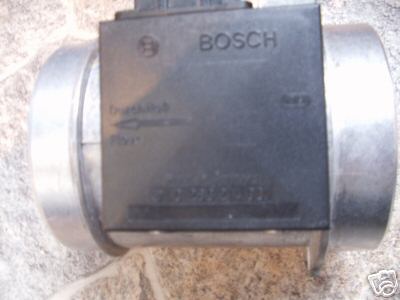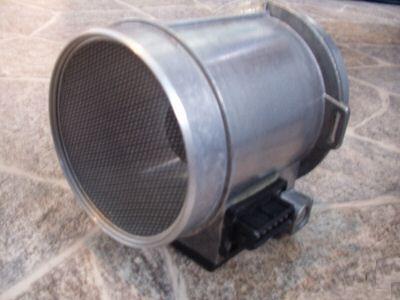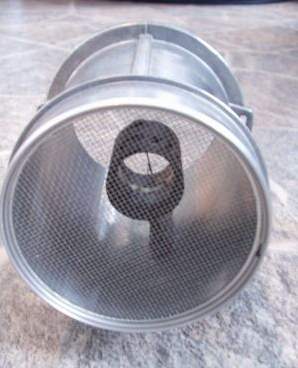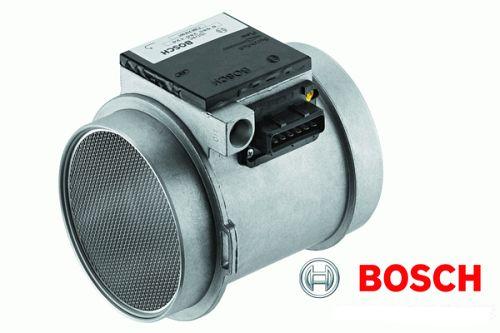




Mass Air Flow meter LH Jetronic
Bosch 0 280 214 001 Air Mass Sensor
Bosch 0 986 280 124 Air Mass Sensor
Porsche 928 606 141 00
BMW 13 62 1 715 888
BMW 13 62 1 311 950
BMW 13 62 1 733 678
VW 035 133 471 AC
Description Years Kw Hp Cc
AUDI - QUATTRO (85) - 2.1 20V Turbo 05.84-07.87 - 225 306 2144
Also used in Audi SQ VW partnumber: 085 133 471 AC
BMW - 5 (E34) - M5 3.6
10.88-05.92 - 232 315 3535
BMW - 5 (E34) - M5 3.6 CAT 10.88-05.92 - 232 315 3535
Also used in BMW M5 partnumber: 1362 1311 950 - 1362 1715 888
PORSCHE - 928 - 4.6 S 08.83-07.86 - 228 310 4664
PORSCHE - 928 - 4.9 S 09.85-05.94 - 212 288 4957
PORSCHE - 928 - 4.9 S,S4 08.86-07.91 - 235 320 4957
PORSCHE - 928 - 5.0 S4 CAT 08.86-07.91 - 235 320 4957
PORSCHE - 928 - 5.0 GT 01.89-07.91 - 243 330 4957
PORSCHE - 928 - 5.0 GTS 01.92-07.95 - 257 350 5397





 0 280
214 001
0 280
214 001
 0 986 280 124
0 986 280 124
MAF burfoff cycle, a few seconds, after shutting down the engine. It clears any depostis on the platinum wire.
==========
Check carefully for vacuum leaks. You can seal off the MAF with a baggie and
rubber band. Disconnect one of the larger vac hoses next to the throttle linkage
(like the one where you sprayed the WD40) and put it to your mouth and blow 'til
you turn red. Listen for air hissing. In the workshop manuals they even show a
rubber cap with a shrader valve stem that you attach to the top of the MAF and
pump air into. Some mechanics also have a smoke machine to pump smoke into the
engine, then you watch for leaks. I suppose you could light a cigar and puff
your own smoke into that vac hose...
If you are pretty sure the vacuum system is tight, then try disconnecting the
MAF and running the engine:
1. Disconnect the battery ground strap (in the rear hatch interior panel where
the tools are).
2. Disconnect the MAF.
3. Reconnect the battery ground strap.
4. Start the car, maybe drive around, with the MAF disconnected.
5. See if there is an improvement.
Without the MAF signal the computer will use a default. It won't run great
(probably rough) but it shouldn't be an erratic idle. No-MAF is usually better
than Bad-MAF.
There are some places that can rebuild the MAF (new hot-wire).
This was one of my problems when I bought my car. I finally found a "PO
enhancement" that was introducing un-metered air.
If it has never been done, I strongly recommend removing the intake manifold and
replacing every piece of rubber you can find.
Let us know how it goes.
John Pirtle
87 a/t 196k
http://members.rennlist.com/pirtle
----
running the engine without a MAF should nomally allow a fairly good and stable 3000rpm.
----
If the car it runs a little better at idle with the MAF disconnected, that does point to a possibly bad MAF. One other thing you can do to check if the wire hasn't broken is to start it and run it for more than 4 seconds then have someone turn it off while you look down the throat of the MAF. The wire will glow white hot for a moment just after shut off. It does this each time the car has been running for more than 4 seconds to burn off any contaminents on the wire.
----
With the MAF disconnected the LH ECU goes into limp home mode. You will get a
good idle, and if you get the revs up it will run reasonably well at around
3000rpm IIRC.
Your car does run better at idle with MAF disconnected, and so MAY be the
problem. But problem could be something else, like O2 sensor, manifold airleak,
low fuel pressure.
Did this problem suddenly happen, or got gradually worse over time ?
It sounds as though the car is running rather weak mixture. Check a hose hasn't
come off, if problem happened suddenly.
Even with a badly aged MAF, the O2 loop should keep the mixture under control at
idle and below WOT (except when you hit the throttle hard).
Sounds like something other than MAF, from what I hear from you so far.
__________________
John '86 Euro S2
JDSPorsche.com
-------
>If I reved up enging after all these chockings and start moving, I runs pretty well, I'd say above 2000 RPM. In fact I am driving this car to work. It is ?pain in butt, though. Did you have same symthoms when your MAF died? Was car drivable?
Yes I could "drive" it but it was putting out rich smoke.
My MAF died while on the highway. During the trip I noticed that the car was not
smooth with the throttle positon - letting up slightly resulted in considerable
deceleration and vice-versa. An hour later when I got off the highway and I had
to clutch I noticed that I had to work the pedal to keep it running while the
clutch was in.
After months of pain and suffering (thinking it was the brain), I borrowed a MAF
and it then ran fine.
If you can't find one to try, let me know and I'll let you try mine (my car is a
part for a while)
-----------
Air Mass Meter Diagnosis.
Setting Base Idle and Mixture on Bosch LH Cars. See the FAQ section above for
tips on base specifications.
Simple Functional Diagnosis of AMM. [Editor] The classic test of AMM failure is
to disconnect it; if the car runs better, then the AMM is at fault. But here are
the OEM tests per the OEM manual for Bosch 2.4 (the-016 AMM):
Check the ground point of the AMM:
-ignition off
disconnect AMM
connect ohmmeter between ground and terminal 1
should be 0 ohms
if not 0 ohms, check the ground point on the intake manifold
Check signal from AMM:
clean off sensor connector, removing any corrosion
-start engine
connect voltmeter between ground and back of terminal 3 on back of connector
should read approx 2.3 volts.
if not approx. 2.3 volts, substitute another AMM
Testing AMMs and Calibration. This is a response from Python Injection
(rebuilders of AMMs) to a question about testing AMMs.
From: Joe Evert, Director of Engineering, Python Injection
Subject: Re: Technical Question about AMM
The reason the OEM doesn't give a test procedure for calibrating the air mass
meter is two fold. First of all BOSCH Hot Wire Air Mass sensors are not linear
devices like a throttle position sensor. The output does not change the same
amount for a given air change. To make it short, most linear sensors will give
you say... 1 volt for 100cfm air flow, 2 volts for 200cfm air flow, 3 volts for
300cfm airflow etc. This is a linear device. Bosch hot wire sensors are not like
this. They change a great deal at low air flows but once the air flow increases
past a certain point, say 50% of what the engine can draw, they change very
little. This makes the sensor very accurate at low to moderate air flows and
good enough at high air flows. Just a small amount of inaccuracy at low RPM and
the vehicle will run terrible. If the voltage for a given air flow is off by 100
milli volts at low RPM the car will barely run. At high RPM A 100 milli volt
deviation will not even be noticed. Because of this it makes it next to
impossible for the technician to accurately diagnose the air mass in the field.
We use a calibrated flow bench that measures the exact CFM air flow to then
compare the voltage to. This is not practical in the field because temperature,
altitude, humidity and the mechanical condition of the engine will affect how
much air the engine is drawing in. So just to say that the Air mass should have
xx.xx volts at idle would be completely false since all these parameters must be
accounted for. Also even if a range is given just a small amount of deviation in
the output causes poor performance.
So what are you to do? For on-vehicle diagnoses the best way is just unplug it
at idle; if the vehicle runs better it is most likely bad. This is because if
the air flow sensor is off voltage at high RPM it will also be off at idle. Also
if you are experiencing repeated failures you probably have a defective air box
thermostat. This little thermostatic bulb is located in the air filter box and
controls the hot air into the engine. When this fails it fails in hot air mode
and routes hot air from around the manifold into the air intake. This will
destroy the air mass meter in no time.
Contaminants on Heated Sensor Wire. [Editor] It is rare but possible to see
contaminants build up on the tiny sensor wires inside the Bosch air mass sensor
due to dirt, spider webs, a disintegrating air filter, etc. In some instances,
the hot burn-off cycle will not remove these contaminants. When this happens, it
skews the ECU transfer function such that the MAF overestimates airflow at idle
(causes the fuel system to go rich) and underestimates airflow at high airflow
(causes the fuel system to go lean). This means that Long Term Fuel Trim will
learn lean (negative) corrections at idle and rich (positive) corrections at
higher airflow and may be the cause of high NOX readings on test. To remedy,
spray the sensor wires inside very carefully with carb or brake cleaner to
remove them, then reinstall and turn the engine on and off to activate the
burnoff cycle.
Cleaning Mass Air Flow Meters. [John Roberson] Post-1996 960/90 cars use a hot
film mass air flow sensor. This can become dirty. To clean it, follow the
instructions. [Lyle Domico] Cleaning the AMM sensor wires, despite their
automatic cleaning cycle, improved my 240's power and economy. Here's how to do
it using CRC Mass Air Sensor spray cleaner (~$7 at auto parts stores):
Remove the AMM from the car to do the best cleaning.
When spraying, use the extension nozzle, and press the button full down to get
max pressure blast. Don't be shy. This stuff dries quick.
DON"T TOUCH the sensor wire.
===============
After diagnosing a failed MAF sensor on my 89 GT, I thought I'd put this out
there for search folder in case someone else has the same symptoms. This entire
progression took place over about a month while driving the car almost daily.
The first symptom began about a month before complete failure with the car
stalling on occasion after full release of the gas pedal when stopping. Usually
it didn't shut down, but it would always dip down too low in the rpm range
before revving back up to normal idle.
The next symptom was very poor performance just after cranking it. It only
happened a couple of times but I was barely able to keep it running after
starting it. Both times, I shut it down and it ran fine after immediately
cranking it again.
Next came the two times that it would not restart after shut down when hot. Both
times I assumed relay, relay, relay and after swapping a few relays, it started
back up and ran fine. The third time this happened, there was no restarting it.
Luckily I was in my driveway. Even when she's bad, she's good. It would fire and
run for a second or two and then stall. If I worked the pedal, I could keep it
going but running very rough.
After swapping a few other items, I tried the MAF sensor and she fired right up
and is running better than it has since the symptoms began. It really helps to
have at least one other running 928 of similar vintage when diagnosing problems.
I recommend they be bought in pairs.
No, 4% is not going to affect the idle issue that Steve has. Unusually for
the UK, his car is a lambda sensor equipped car, so MAF ageing less critical.
The Lambda sensor adjusts the LH if the mixture partly is too rich or lean. However the
aged MAF will afffect throttle response as the LH goes open loop under those
conditions, ignoring the lambda.
----
3% aged is my advised limit for optimum drivablilty and power.
===
MAF pin 1 is the burn of voltage (5v) when activated by the LH ECU.
Pin 2 should have 12v when ignition is on
Pin 3 & pin 4 are both ground. To test voltages at the MAF, connect 3 & 4
together.
Pin 5 is the output volts to the LH - residual volts with no airflow about 1.8v,
increasing with airflow. About 2.7v at idle speed.
Pin 6 is the idle CO pot, only in circuit on 84-86 cars.
Theo
====